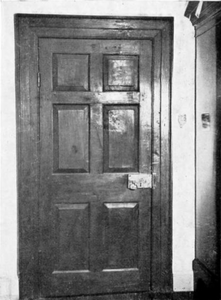
Dolwyddelan Castle is a Welsh castle located near Dolwyddelan in Conwy County Borough in North Wales. It is thought to have been built in the early 13th century by Llywelyn the Great, Prince of Gwynedd and Wales. Initially comprising just one tower with two floors, a second tower was built in the late 13th century, and a third floor was added to the first during repairs in the late 15th century.
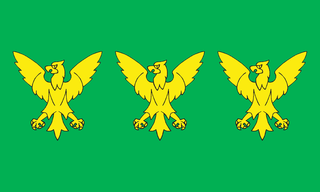
Caernarfonshire, historically spelled as Caernarvonshire or Carnarvonshire in English, is one of the thirteen historic counties, a vice-county and a former administrative county of Wales.
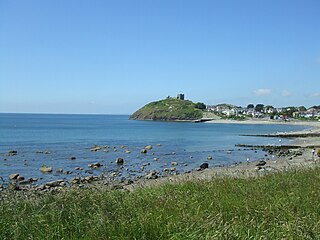
Criccieth is a town and community on the Llyn peninsula in the Eifionydd area of Gwynedd in Wales. The town lies 5 miles (8 km) west of Porthmadog, 9 miles (14 km) east of Pwllheli and 17 miles (27 km) south of Caernarfon. It had a population of 1,826 in 2001, reducing to 1,753 at the 2011 census.

Llanystumdwy[ɬanɪstɪmdʊɨ] is a predominantly Welsh-speaking village, community and electoral ward on the Llŷn Peninsula of Gwynedd in Wales. It is not regarded as being part of Llŷn, but as belonging instead to the ancient commote of Eifionydd on the Cardigan Bay coast, where it has its own beach. The community includes the villages of Chwilog, Afon Wen, Llanarmon, Gwynedd, and Llangybi, Gwynedd, plus the hamlets of Rhoslan and Pencaenewydd.

Sir John Wynn, 1st Baronet, was a Welsh baronet, Member of Parliament and antiquary.

Tŷ Newydd is a historic house in Llanystumdwy, near Criccieth, in Gwynedd, north-west Wales. Since 1990 it has housed the National Writing Centre of Wales. The centre specialises in residential creative writing and retreats. The courses are in both the English and Welsh languages, and cover many genres, forms and styles. The centre also holds regular seminars and forums.

Llandygai is a small village and community on the A5 road between Bangor and Tal-y-Bont in Gwynedd, Wales. It affords a view of the nearby Carneddau mountain range. The population of the community taken at the 2011 Census was 2,487. Llandygai community includes nearby Tregarth and Mynydd Llandygai and also the pass of Nant Ffrancon.
Thomas Ellis was a Welsh clergyman and antiquarian.
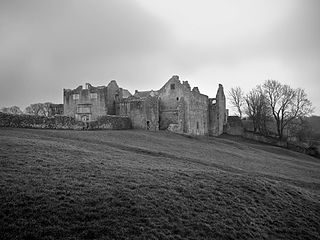
Old Beaupre Castle is a ruined medieval fortified manor house located in the community of Llanfair, outside Cowbridge in Wales. It is known in historic documents under the names Beawpire, Bewerpere, Bewpyr and Y Bewpur. It is a Grade I listed building and is presently under the care of Cadw. It can be visited free of charge all year round by members of the public.
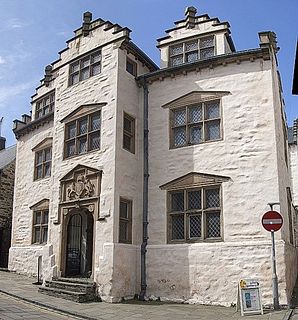
Plas Mawr is an Elizabethan townhouse in Conwy, North Wales, dating from the 16th century. The property was built by Robert Wynn, a member of the local gentry, following his marriage to his first wife, Dorothy Griffith. Plas Mawr occupied a plot of land off Conwy's High Street and was constructed in three phases between 1576 and 1585 at a total cost of around £800. Wynn was known for his hospitality, and the household was supported by Wynn's local dairy herds, orchards and gardens. On his death he laid out complex instructions for dividing his estate; the resulting law-case took years to resolve, effectively preventing the redevelopment of the house and preserving it in its original condition.

St Cynhaearn's Church is a redundant church standing in an isolated position on Ynyscynhaearna, a former island in Llyn (Lake) Ystumllyn, 900 metres (980 yd) south of the village of Pentrefelin, near Criccieth in Gwynedd, Wales. It is designated by Cadw as a Grade II* listed building. The church is approached from the village by an ancient causeway, and is in the care of the Friends of Friendless Churches.

Llaneilian is a village and community in the Welsh county of Anglesey. It is located in the north east of the island, 2.2 miles (3.5 km) east of Amlwch, 16.5 miles (26.6 km) north west of Menai Bridge and 12.5 miles (20.1 km) north of Llangefni. The community includes the villages and hamlets of Dulas, Llaneilian, Pengorffwysfa, Cerrig Man and Penysarn, Gadfa and Nebo, and at the 2001 census had a population of 1,192, decreasing slightly to 1,186 at the 2011 Census. The parish is crowned by its hill, Mynydd Eilian, a HuMP, popular with walkers and ramblers, and its beach, Traeth Eilian, which is popular with holidaymakers and for watersport activities. At the north easternmost point is Point Lynas,, while Ynys Dulas lies off the North East coast of the island, east of Dulas Bay.
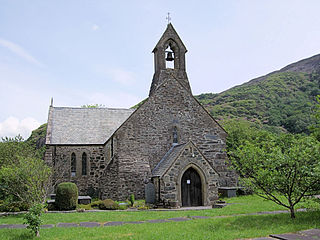
The Priory and Parish Church of Saint Mary is in Beddgelert. It is a Grade: II* Listed Building, on the site of one of the oldest Christian establishments in Wales. An early Christian community was established there in the 6th century AD which is mentioned by Gerald of Wales. An Augustinian priory was founded there in the 13th century and in the Middle Ages it grew substantially thanks to the support of important Welsh nobles including Prince Llewelyn.

Eglwys y Bedd is all that remains of a 14th-century church in Anglesey, north Wales. It is set within the churchyard of St Cybi's, Holyhead, and may have been built on the site where Cybi lived and ministered. It is reputed to house the grave of Seregri, an Irish warrior who lived in the area in the 5th century.
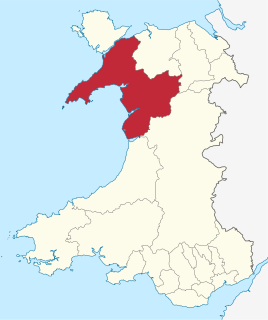
Gwynedd is a large rural county in North Wales. The northern half includes the high mountains of Snowdonia and the mixed farmland and hills of the Llŷn peninsula, which between them make up much of the former county of Caernarfonshire. The southern part of Gwynedd is the softer coastal and upland landscapes of the former county of Merionethshire. Gwynedd, the second-largest county in Wales, has a total of 497 scheduled monuments. That is too many to have on a single list article, so for convenience the list is divided into three. The 365 prehistoric sites are in two lists, covering 171 sites in former Merionethshire, and 194 sites in former Caernarvonshire. The 132 sites dating from Roman to modern times are included in a single list covering the whole of the county. Gwynedd is a unitary authority comprising most of the two historic counties. In 1974 it also merged with Anglesey, and the merged county was also called Gwynedd. Since 1996 Anglesey has been a separate county again.

Peniel Chapel is a former Calvinistic Methodist chapel in Tremadog, Gwynedd. It is one of five Grade I-listed nonconformist chapels in Wales. It is in a neoclassical style inspired by mid-17th century St Paul's Church in Covent Garden, London. Its interior theater auditorium concept influenced Welsh church architecture from the nineteenth century.

Pont Aberglaslyn is a bridge over the Afon Glaslyn and the surrounding hamlet, located near Beddgelert and Nantmor in Gwynedd, north-west Wales. A well-known beauty spot, according to Peter Bishop it was "one of the most visited sites in north Wales" at the end of the eighteenth century; an 1883 guidebook wrote that it "has occupied the artist's pencil perhaps more than any other".
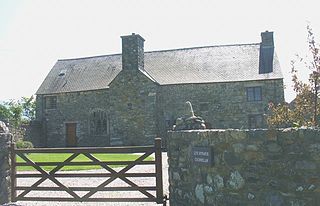
Cochwillan is a medieval hall house situated in the lower Ogwen Valley, south of the village of Talybont in the parish of Llanllechid, between Bethesda and Llandygai. It is designated by Cadw as a Grade I listed building.

John Ystumllyn, also colloquially known as Jac Du or Jack Black, was an 18th-century Welsh gardener and the first well-recorded black person of North Wales.

Hafotty, Llansadwrn, Anglesey, Wales is a medieval hall house dating from the mid 14th century. Described in the Gwynedd Pevsner as "one of Anglesey's classic small medieval houses", Hafotty is a Grade I listed building and a scheduled monument.







